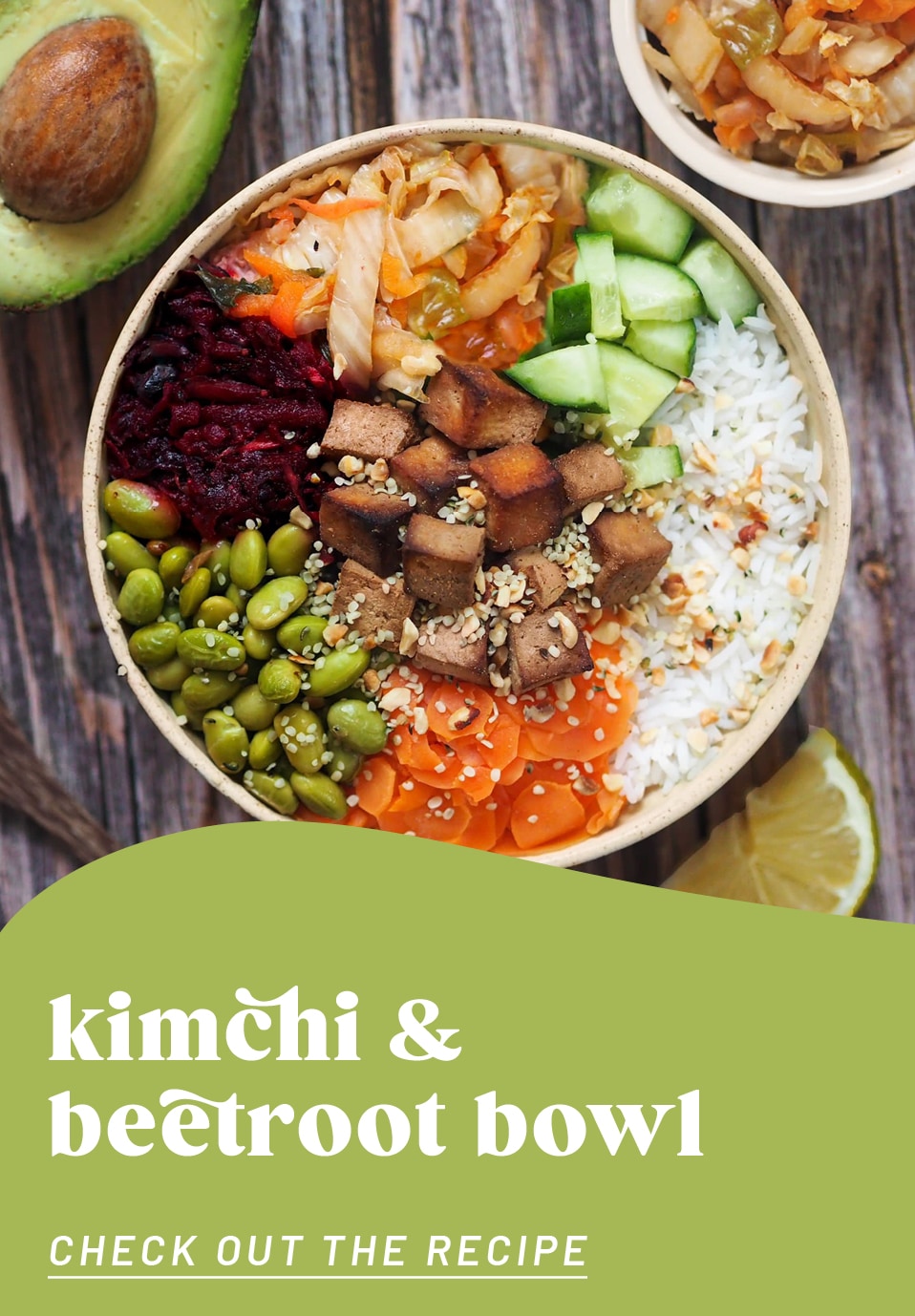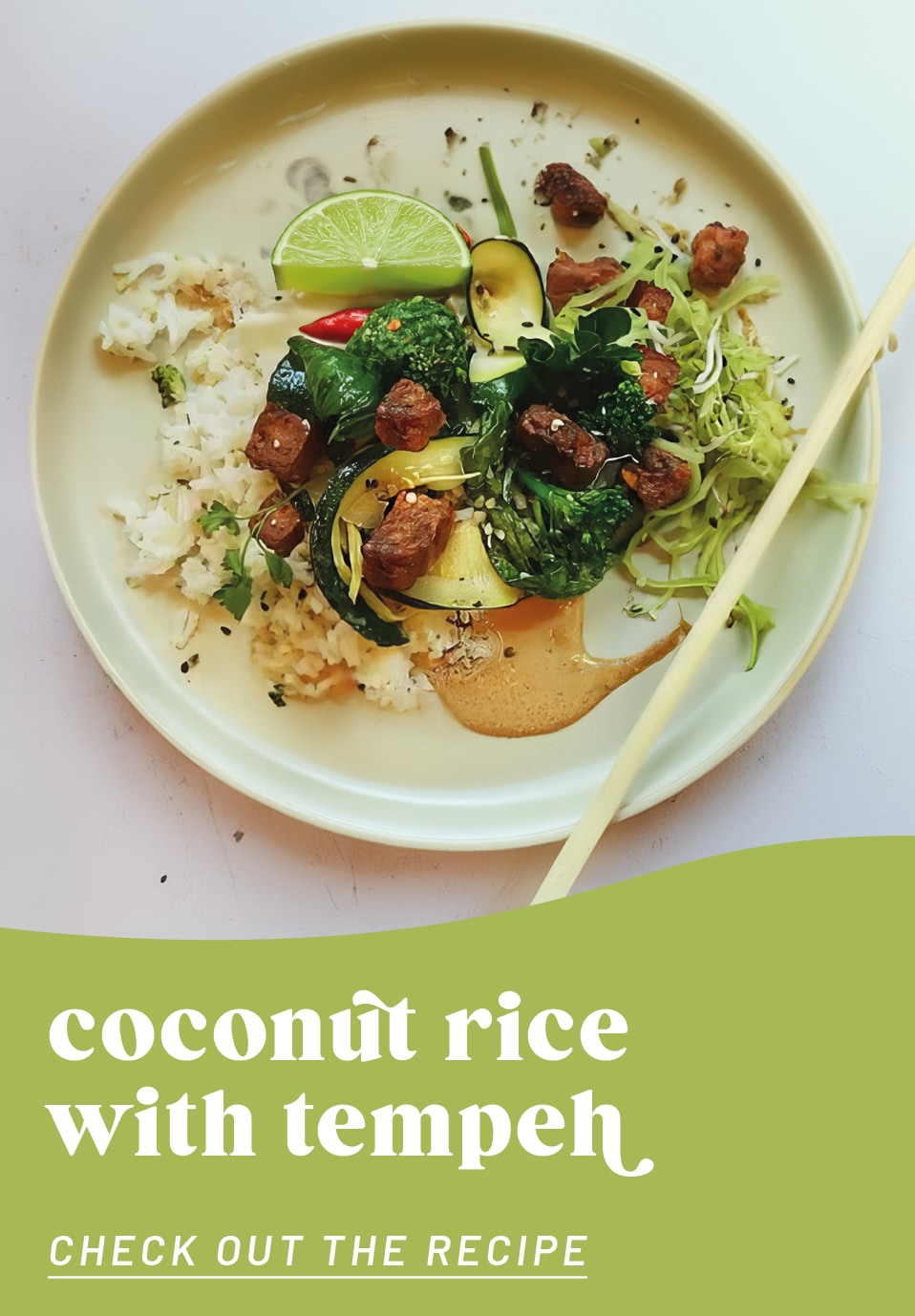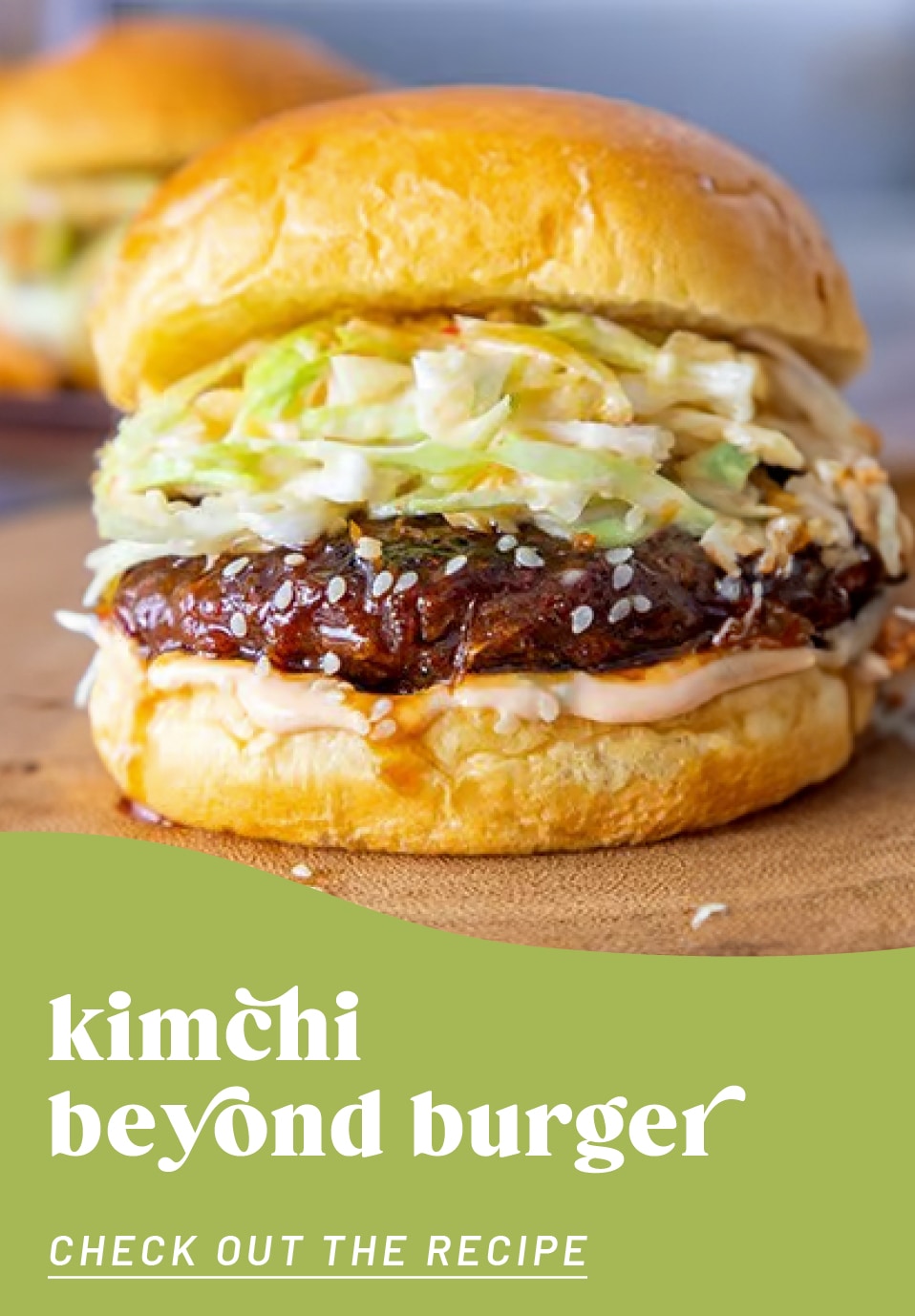BRAND STORY
Kimchi, miso & co. – fermented superfoods

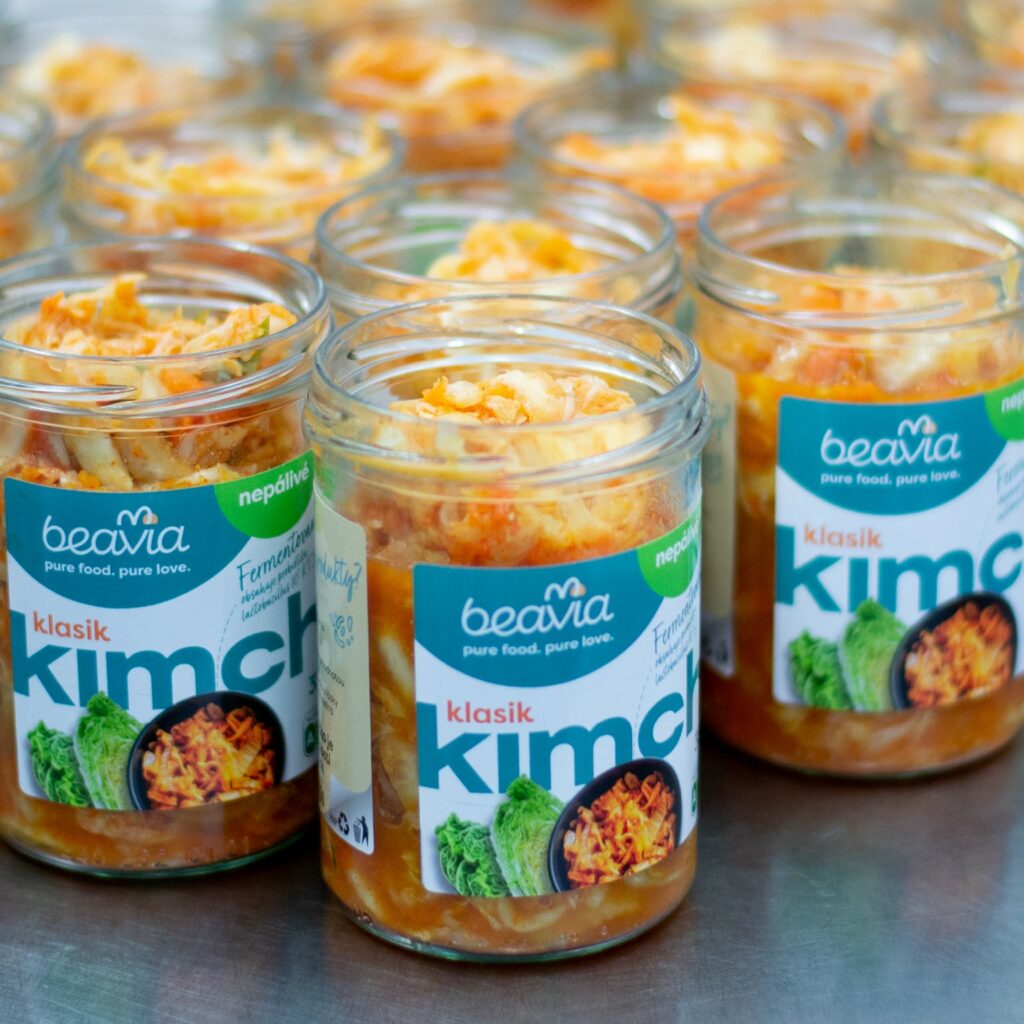
Durable, digestible, delicious – discover kimchi from Beavia and how to ferment it yourself
Whether tempeh or yoghurt, kefir or kimchi – fermented foods are all the rage. Yet this processing method is ancient. New discoveries show that fermented delicacies can be stored perfectly, are your gut’s best friend and add a delicious fresh taste to many plant-based dishes. Find out all about the variety, production and use of these „active“ foods – with step-by-step instructions. Štěpán Hodač, CEO of Beavia, also reveals exciting facts about the trendy food kimchi in an interview. Of course, we also have delicious recipes to accompany it.
What are fermented products?
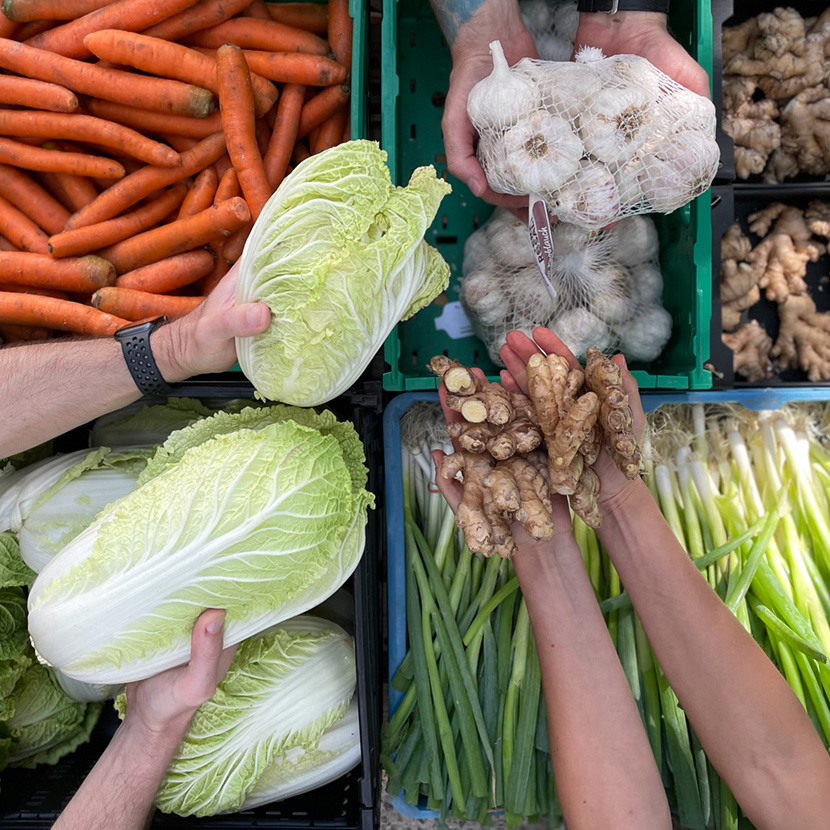
Like domestic sauerkraut, Korean kimchi is produced by fermentation processes. The little helpers in this process are microorganisms such as healthy bacteria, fungi or yeasts. They convert carbohydrates or natural sugars found in food into lactic acid or alcohol. This acid in turn inhibits the spread of other bacteria and thus stops rotting and decay. This is the age-old trick for preserving foods such as vegetables. In the old days, this was used to store provisions during the winter so that food rich in vitamins was also available during the cold season. And all without preservatives!
However, in addition to vegetables, milk has always been processed by fermentation into yoghurt, kefir, whey and cheeses such as feta. The good news for vegan fans is that this works just as well with plant-based milk alternatives. Yoghurt and other dairy alternatives can also be produced from soya, oat, coconut and almond drinks by adding the right microorganisms.
Whether vegetables or plant-based drinks, this natural fermentation also changes the flavour and nutritional composition of the food used. Many people love the slightly acidic and spicy flavour. It adds a new facet of flavour to vegan cuisine in particular. A pinch of miso paste – yes, it is fermented – in your soup oder and a dollop of kimchi in your bowl is often enough to spice up your meal and give it a fresh kick.
Ferment your own vegetables – here’s how
Sauerkraut is world-famous. It is one of the most popular fermented foods. Have you ever thought about making your own sauerkraut from cabbage? Or have you ever dared to make your own kefir? Or pickling vegetables? Let’s start with this …
The equipment you will need:
• A preserving jar with a lid. A jar with a special valve lid is often recommended, from which the fermentation gases can escape during fermentation.
• A heavy object (such as a stone or glass) to weigh down the pickled vegetables.
• Use a pestle or spoon to press the vegetables together in the jar.
• Sea salt
Ferment your favourite vegetables step by step:
- Wash your vegetables thoroughly, cut them into small pieces and massage them a little. This breaks up the cell structure.
- Add 2 grams of salt per 100 grams of vegetables and season to taste.
- Layer your vegetables in a sterilised jar and press firmly with the pestle.
- Weigh down your pickled vegetables with an object that can be washed.
- Close the jar. For lids without a valve, simply place the lid on top to allow the gases to escape. Place your jar in the dark at room temperature.
- The salt draws out the liquid from the vegetables. After a few days, this covers the vegetables, preserving them. You can now refrigerate your jar.
- Depending on the type of vegetable, fermentation can take just 4-5 days or several weeks. Find out more! As a rule of thumb: the longer you ferment, the longer it will keep.
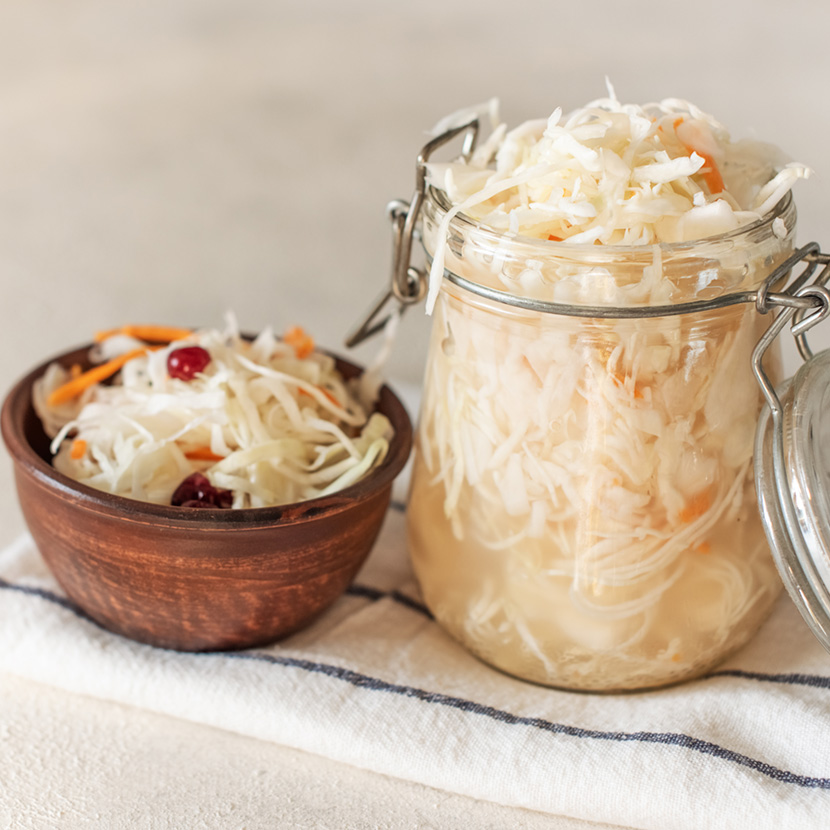
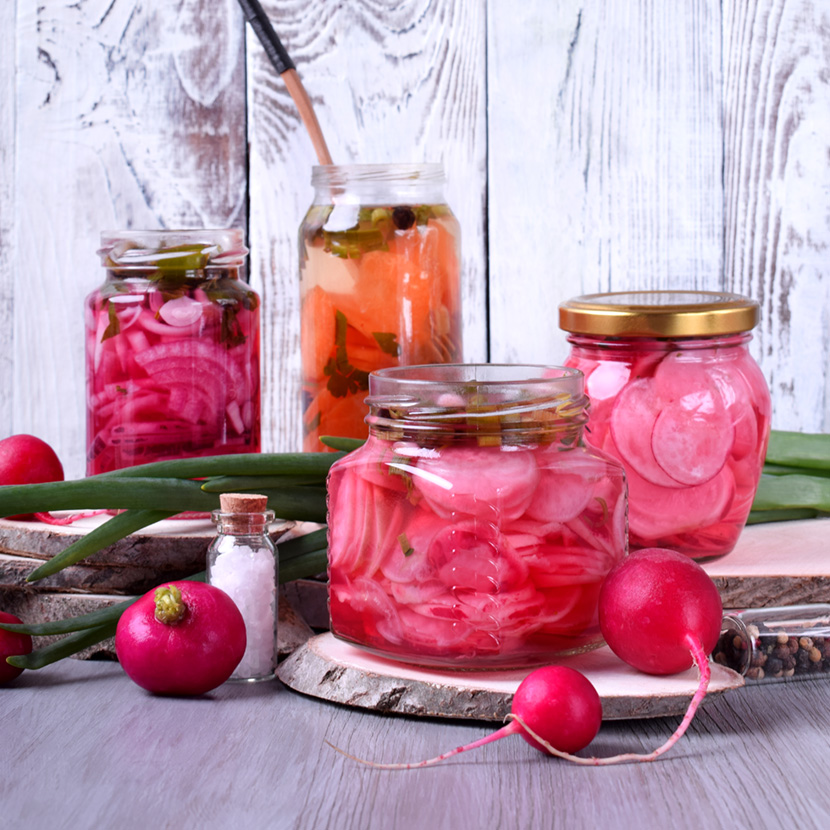
In addition to this dry fermentation method, there is also the brine method. In both cases, kitchen hygiene, such as boiling the jars, is crucial! If you are now wondering which vegetables you can use: basically almost anything. Firm vegetables such as white, Chinese and red cabbage, carrots, ginger, cucumber, beetroot, radish, celery, fennel or radishes are well suited. Soft vegetables such as tomatoes, or even fruit, tend to get mushy, but can still taste quite good. You can now find tutorials and courses on this topic everywhere. You’ll become a fermentation expert in no time at all. And another extra tip: some companies, such as Fairment, offer starter cultures for pickling vegetables as well as for sourdough, kombucha and other fermentations. Their yoghurt starter is also vegan and therefore suitable for experimenting with plant-based drinks. So go ahead, get stuck into the probiotic fun!
The secret of natural probiotics
The so-called fermentation starter culture, i.e. the added microorganisms, not only creates a different nutrient profile and a favourable pH value of the food, but also food for our microbiome. This is because probiotic bacteria promote the growth of healthy intestinal bacteria in a slightly acidic environment, strengthening the intestinal flora and thus the immune system. It is becoming increasingly clear that intestinal health is the key to well-being. Fermented foods give a real booster. Fermented foods are therefore considered to be easily digestible, healthy for the digestive and immune systems and ideal for weight control. However, we advise you to find out more about fermented foods, as they are not recommended for histamine intolerance, for example.
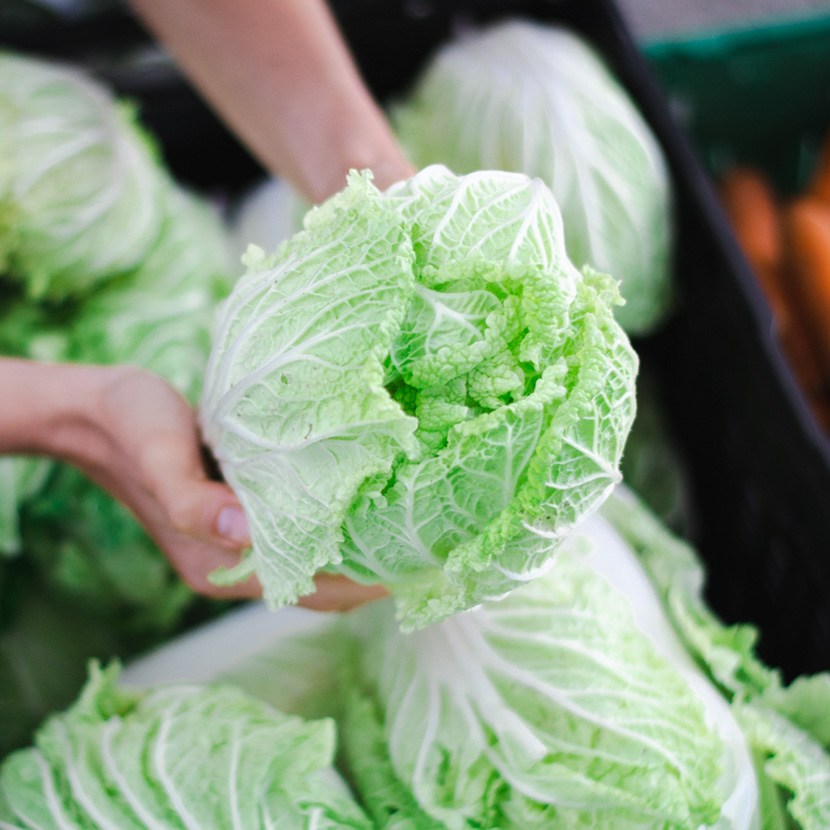
Top 10 fermented vegan foods:
1. Sauerkraut: Sure, we know it from traditional German cuisine. A winter vitamin booster!
2. Fermented or pickled vegetables: The sky is literally the limit! Firm vegetables are particularly suitable. The gherkins/cornichons and olives that you buy are also fermented.
3. Kimchi: You’ll find out more about this Korean speciality, which is also popular here.
4. Yoghurt alternatives based on fermented coconut, oat, pea or soya drinks. You can find a wide selection here.
5. Kombucha: A fermented tea originally from China made of either green or black tea, which has become a special favourite with some foodies. Three different fermentation processes take place: alcoholic, lactic acid and acetic acid fermentation.
6. Apple cider vinegar: Produced by fermenting apple juice with acetic acid bacteria. Traditionally used both in the kitchen and in naturopathy.
7. Sourdough bread: A dough made from water, flour and microorganisms (available as starter kits) makes the bread particularly digestible and flavourful. Within the baking community, sourdough is regarded as the pinnacle in the art of bread making.
8. Miso: This savoury paste made from fermented soybeans is particularly popular in Japan.
9. Soya sauce: This classic from Asian cuisine is an all-rounder in plant-based cooking.
10. Tempeh is a popular meat alternative made from fermented soya beans and is therefore a good source of protein.
We would like to encourage you to incorporate more fermented foods into your diet if your body can tolerate them. For example, how about good overnight oats for breakfast, a kimchi bowl during your lunch break or crispy tempeh skewers with peanut sauce in the evening?
We now introduce you to the trendy vegetable– kimchi, a highlight from Korean cuisine. Similar to sauerkraut, it is a lacto-fermented cabbage (or another vegetable). However, kimchi really packs a punch; it is really spicy. A savoury treat for the palate! We spoke to the European kimchi producer Beavia to find out more.
Korean kitchen star kimchi – in conversation with the experts from Beavia

VELIVERY: Hello Mr. Hodač. You are the owner of Beavia. How and where did Beavia start; what is the initial idea behind it?
Štěpán Hodač: It all started with a production of hummus in 2011. We’ve come a long way since then and it’s not just about hummus anymore. I passionately set out to fulfil my own dream in 2011. After several visits to the Middle East and sampling typical dishes, I fell under the spell of Israeli traditions. A few months later I started a small family business in the Czech Republic called ‘I love Hummus’. Shortly afterwards, my 84-year-old grandmother, who had been watching over the chickpeas from the beginning, could no longer manage the chickpea pots on her own. The team began to expand, as did the product range. In 2017, I included kimchi among my products. And it was a success! A move to a new factory, new flavors, a growing team, exports to neighboring countries, and the arrival of my son Josef. In 2021, to mark the tenth anniversary of the founding of the company, we decided to launch a new product line under the brand Beavia – pure food. pure love (beavia means ‘happy journey‘ in Latin) is focused on the production of fermented food. Beavia is the next chapter in our story about the love of good food and a healthy lifestyle.
VELIVERY: What is your mission?
Štěpán Hodač: Our mission is to make people go back to being more in touch with themselves and nature through savoring high quality and delicious food, so that they can eat better, feel better and be well balanced.
VELIVERY: What is kimchi?
Štěpán Hodač: Kimchi is a fermented, probiotic salad prepared from pickled and fermented vegetables. The basic ingredient is traditionally Napa cabbage. It is Korea’s national dish, which Koreans have been eating, mostly with rice, for over 2,000 years.
The magic of kimchi
VELIVERY: What is so special about kimchi and why do you recommend incorporating kimchi more and more into a plant-based diet?
Štěpán Hodač: Kimchi is classified as a superfood which boosts immunity, improves the balance of intestinal microflora and helps with digestion. It ranks among the 10 healthiest food items in the world (Health magazine). Let’s have a detailed look at Beavia kimchi.
- It is unpasteurized, i.e. a living product. It contains the probiotics Lactobacilli. One gram of kimchi contains 10,000,000 friendly bacteria.
- It is produced without added preservatives, coloring agents or sugar.
- It is gluten and lactose free and suitable for vegans and vegetarians.
- It is low in energy – a great companion when losing weight.
- It has a low glycemic index, which in practice means that we stay more satiated for longer after a meal.
- You can enjoy it any time during the day straight from the jar, as a salad at every meal, or you might experiment and prepare kimchi soup, a kimchi burger etc. Doesn’t it sound great? It’s an all-round healthy dish which you can eat anytime.
VELIVERY: It sounds as though kimchi only has pros; does it also have some cons?
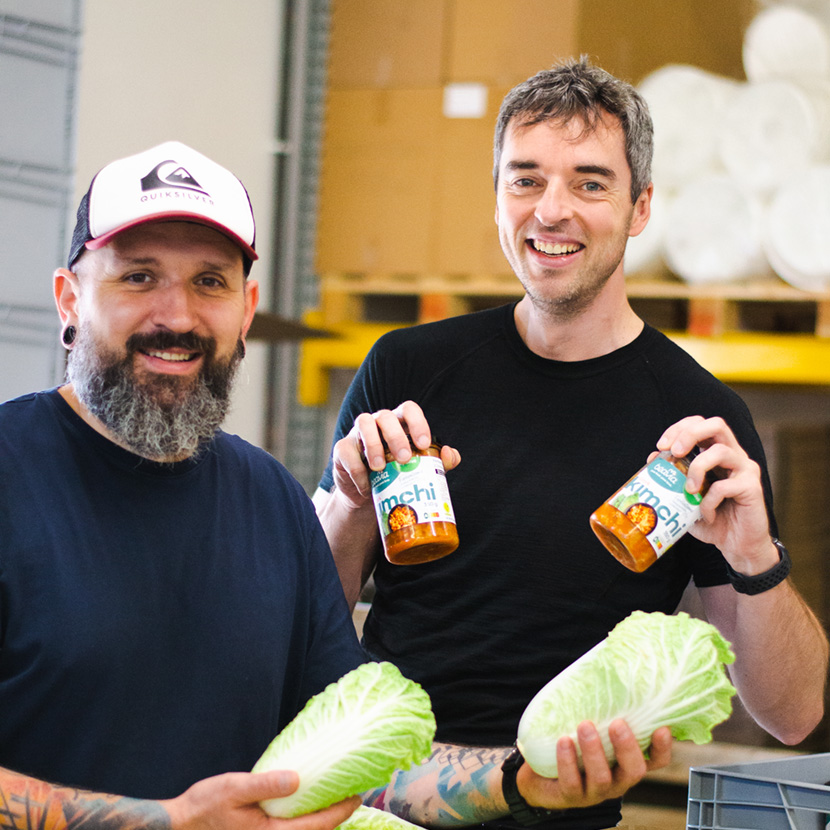
Štěpán Hodač: Of course, like all fermented food, it has its own specific aroma. The lid may become bloated and may allow gases to escape. Once opened, the contents may leak. That’s fine; it is a natural manifestation of the activity of probiotic cultures. It’s also fine when kimchi ‘bubbles’. People might be scared and start to wonder if the product is okay to eat. Don’t worry about it – just enjoy your kimchi 🙂
VELIVERY: What sorts of kimchi are there?
Štěpán Hodač: Well, you have plenty of options. For example, in Korea there are over 200 types of kimchi and thousands of recipes. Every family has its own recipe. Every kimchi is different. They may differ in spiciness, acidity, crispness, size of the pieces, but they always have one thing in common – they are fermented. At Beavia, we prepare 2 types of kimchi. One made from Napa cabbage, and the other one from white cabbage in a spicy and a non-spicy version.
Renaissance of an ancient secret
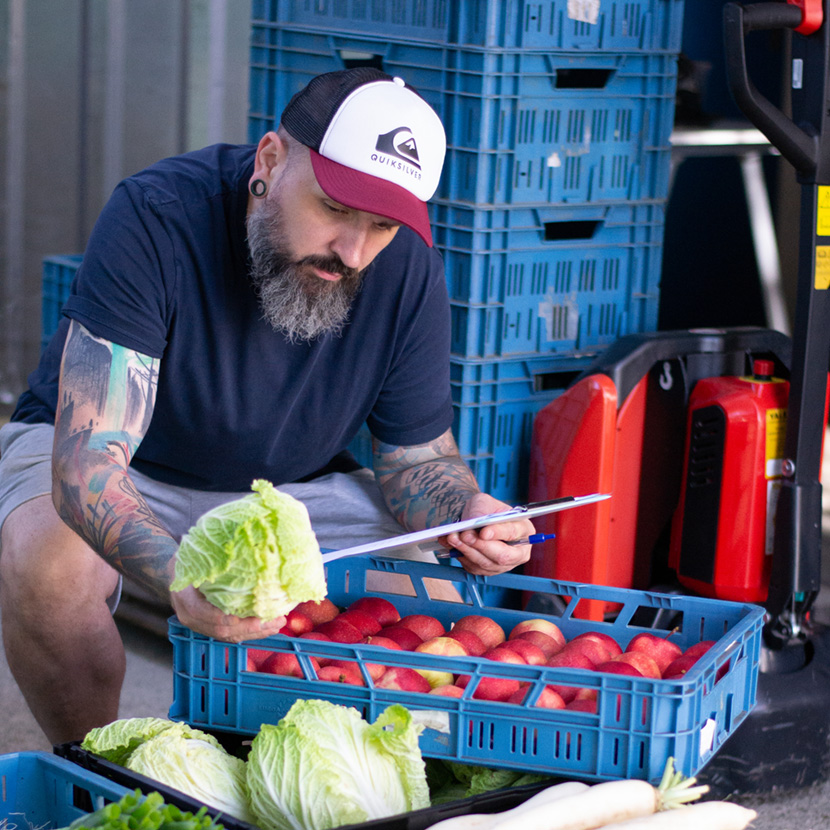
VELIVERY: It seems to revolve all around fermentation. What is fermentation?
Štěpán Hodač: Fermentation is something we all enjoy every day. The magic of fermentation was already known to our grandmothers as an age-old way of preserving food without refrigeration and without adding any kind of additional preservatives. It is the process of converting organic matter from more complex substances to simpler ones using friendly bacteria and their enzymes. The conditions created during fermentation are unfavorable for any hostile bacteria that cause food to spoil.
VELIVERY: We hear a lot about fermented food nowadays and foodies discovered it a while back. But do you consider it to be a hype or is it a promising and future-proof movement?
Štěpán Hodač: Fermentation is as old as mankind itself; one might state in a somewhat exaggerated way. Rather than being a trend, I would call it a renaissance; trends will pass, but fermented food will still be with us. Yoghurt, for example, is also fermented and we know about its beneficial effects. Nowadays fermented vegetables have come to the fore and are even healthier.
VELIVERY: What effect do fermented foods have? And why may this be interesting especially for people with a vegan lifestyle?
Štěpán Hodač: Fermented delicacies provide our bodies with beneficial probiotic bacteria and enzymes to aid our digestion, to improve the balance of intestinal microflora and to support our immunity. They are a great companion while cutting calories or being on other diets. They are rich in fibre and compared to fresh vegetables are easier to digest. As Vegans do not consume dairy products, fermented plant-based foods such as sauerkraut, kimchi, tempeh, miso, or kombucha provide an alternative source for these beneficial probiotic bacteria.
More umami-boosters from Beavia
VELIVERY: What other vegan products does Beavia offer at Velivery?
Štěpán Hodač: We have recently extended our offer at Velivery. In addition to Beavia fermented salads, you can now also enjoy our spices: Yumchi sauce, liquid seasoning Luggi and barley-chickpeas miso paste – all with no added preservatives, artificial coloring or sugar. Completely natural. Suitable for seasoning and marinating almost all dishes such as soups and salads. Yumchi sauce carries the signature touch of Pavol Pavlík, holder of the Michelin Bib Gourmand Award. Yumchi is a culinary revelation with vibrant hints of paprika, the warmth of ginger, and savory flavors of onion and garlic. It’s thick and creamy. A base for stews, soups or marinades. Luggi is a mixture of lupines, oats, salt and water, fermented for more than six months, soy and gluten-free. It has the fifth flavor –umami (delicious, a mature flavor). It is the perfect substitute for Maggi and soy sauce. Miso is a traditional Japanese spice paste naturally fermented for about ten weeks. Our miso is classified as a Shiro (light) miso with chickpea pieces. It is umami. Generally speaking, miso is often a good substitute for bouillon.
VELIVERY: Any tips for vegan cuisine?
Štěpán Hodač: My favorite way to enjoy kimchi every day is as a salad accompanying every meal. Yumchi is one of my new addictions; one spoon added to any dish creates a nice explosion of flavours. Some tips would be: kimchi miso soup, kimchi or beet burger, scrambled eggs with kimchi…
VELIVERY: How do you see the future of kimchi and fermented food?
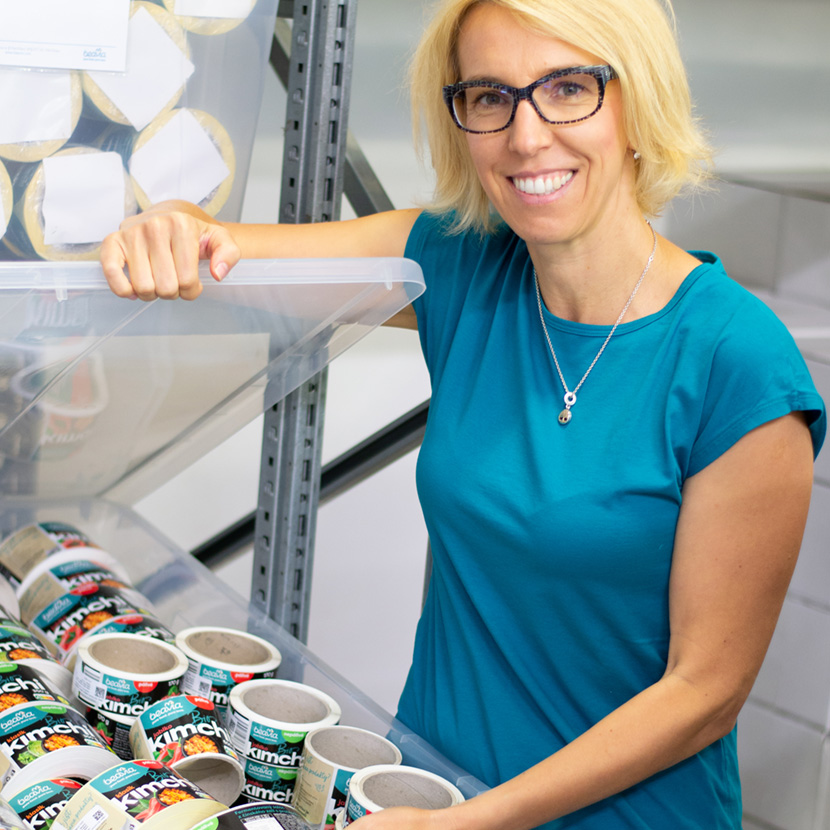
Štěpán Hodač: As mentioned before, the magic of fermentation was already known to our grandmothers. Fermented foods have always been and will always be here. We are committed to making kimchi and our other fermented products a permanent part of our menus because that’s the only way we can make a difference. We are currently seeing some changes in consumer behavior. Consumers bear more responsibility for their health, which consists of diet, mindfulness and exercise. It is because of this change in attitude that we believe fermented foods will play a much bigger role in our diets.
VELIVERY: Thank you very much for these interesting insights and views.
Štěpán Hodač: I would like to thank Velivery. I hope you all have lots of fun with kimchi and as we say at Beavia: Happy gut, happy life. Join us on our Beavia journey.
Fermentation – an ingenious rediscovery
It is not without reason that fermented superfoods such as kimchi are making a comeback among the nutritionally conscious. A real (re)discovery, especially for a vegan lifestyle!
Fermenting vegetables is also a fantastic way to utilise leftovers and therefore waste less food. For example, if your garden or balcony gives you an abundance of produce in the summer, you can start fermenting. It also makes a great gift.
Recipes
Do you want to get started with some fermented delicacies right away? We have 3 recipes for you, including homemade kimchi for a delicious burger:
